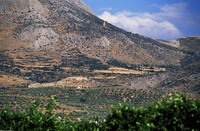Mycenae [site]
unknown (Mycenaean)

Download1A3-MY-MP-A3_cp.jpg (717.1Kb)
Date
-1600--1050Description
Distant view of the site, from the northwest looking over the Argive Plain, closer view; Site in the north-eastern Peloponnese in southern Greece, 30 km south-west of Corinth. It is renowned for its Late Bronze Age (LBA) palace, tombs and fortifications. In Homeric epic it was the capital city of Agamemnon, leader of the Greek forces at Troy, and it now gives its name to the Mycenaean civilization. Mycenae stands on an isolated hill separated by two ravines from Mt Zara and Mt Ayios Ilias and forms a natural strongpoint controlling the route from the Peloponnese to central Greece. Combined with its proximity to the sea, this made Mycenae the key point on the trade routes between the Aegean and the eastern Mediterranean on one side and Greece and central Europe on the other. There are nine tholos tombs, and two royal burial enclosures, Grave Circle A and Grave Circle B. (LH I period) The south-west fortification wall was dismantled in LH IIIB, and a new entrance, the Lion Gate, was erected, protected by an outwork on the right. The regular courses of rectangular stone blocks around the Lion Gate and the North Gate contrast strikingly with the rough Cyclopean masonry of the earlier fortification wall. Source: Grove Art Online; http://www.groveart.com/ (accessed 1/27/2008)
Type of Work
excavation (site); palace; fortificationSubject
architectural exteriors, Mycenaean, Late Bronze Age
Rights
Rights Statement
Licensed for educational and research use by the MIT community only